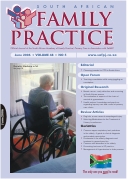Breast cancer – early detection and screening in South African women from the Bonteheuwel township in the Western Cape: Knowledge, attitudes and practices
Abstract
Background Breast cancer is one of the most common cancers, rating among the most frequent causes of mortality in women worldwide, including in South Africa. Although curative treatment is increasingly successful, early detection and intervention are critical in reducing mortality rates. Early diagnosis is facilitated via breast self-examination (BSE), clinical breast examination (CBE), and mammography. Breast cancer presentation shows an apparent racial variation, with black, coloured and Indian patients presenting at a younger age than whites. In addition, whites tend to present at earlier stages of disease severity, coloureds and Indians at more intermediate stages and blacks at later stages. Socio-economic variables impact on screening practices. One American/Canadian study showed women with higher education and incomes were more likely to receive screening. In South Africa, there is scant research on breast cancer screening. In 2001, Prof. Karl Peltzer of the University of the North did a small telephonic comparative study between black and white women that identified low frequencies of BSE in both groups. Further research is necessary. While several international studies exist, little research is available on the screening behaviour of South African women. The aim of this study, therefore, was to evaluate the knowledge, attitudes, and actual screening practices regarding breast cancer among women in the Bonteheuwel township in the Western Cape. Methods A random sample of 100 women completed a questionnaire administered by a research assistant. A separate, selected group of nine women participated in a focus group discussion. Results The results indicate that the majority of the participants were aware of the dangers of breast cancer, perceived as a common (87%; 95% CI: 80%-94%) and serious (88%; 95% CI: 82%-94%) disease, which, if treated early, could be cured in most cases (82%; 95% CI: 74%-90%). Most had previously examined their breasts (65%; 95% CI: 56%-74%) and/or had been examined by their doctors (62%; 95% CI: 52%-72%). Only a minority, however, practised regular BSE (24%; 95% CI: 16%-32%) or had received a CBE in the last year (29%; 95% CI: 20%-38%). Fear of diagnosis was identified as the main barrier to screening (87%; 95% CI: 80%-94%). Despite their fears, the participants were keen to improve their knowledge and participate in the further education of their community. However, only 40% (95% CI: 30%-50%) had ever been taught BSE by a healthcare professional. Moreover, only 34% (95% CI: 25%-43%) of women who had consulted a GP in the preceding year had received a CBE during this period. A total of 38% (95% CI: 28%-48%) had never had a CBE in their lives. Conclusion The participants were better informed and more engaged in screening than had been anticipated. Still, healthcare professionals need to play a more proactive role in breast cancer screening and education.
Issue
Section
Original Research
By submitting manuscripts to SAFP, authors of original articles are assigning copyright to the South African Academy of Family Physicians. Copyright of review articles are assigned to the Publisher, Medpharm Publications (Pty) Ltd, unless otherwise specified. Authors may use their own work after publication without written permission, provided they acknowledge the original source. Individuals and academic institutions may freely copy and distribute articles published in SAFP for educational and research purposes without obtaining permission.

